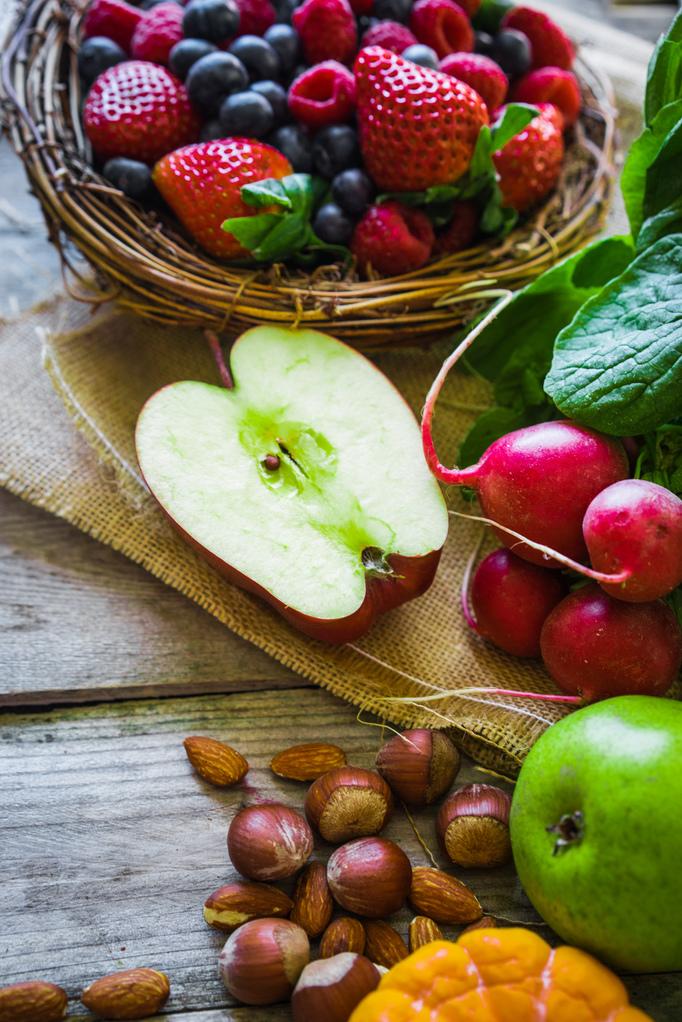I love to see people's reactions when I meet them for the first time and it comes out that I'm a nutrition consultant.
If this happens to be at a party and they're holding a plate full of unhealthy snack foods, they usually get embarrassed and try to hide their plate.
Or they may claim to eat "pretty good most of the time" but when I ask them what "pretty good" means, it usually ends up being pretty BAD.
And here's my favorite--when someone will say to me, "Well, my diet's not the best, but I'm religious about taking my vitamins every day. So I'm covered, right?"
My answer: Not quite. You see, to truly be "covered," you'd probably have to take upwards of 2,000 supplements a day, and even then you won't come close to getting what your body gets from real foods.
As they lift their chin up off the floor and gag at the thought of choking down that many pills every day, I explain why.
So much more than vitamins
Most people are aware that a healthy diet of real foods provides vitamins, minerals, amino acids, fatty acids, glucose and fiber that your body needs.
And it's virtually impossible for a supplement to cover ALL bases as far as those nutrients are concerned.
But that's just the tip of the iceberg.
Because there is another classification of nutrients from your foods that continues to emerge left and right to the tune of over 2,000 so far.
They're not even considered a "formal" nutrient category yet and no RDAs (recommended daily allowances) have been established for them, but their benefits to your body and overall health are enormous and well-documented.
I'm talking about phytonutrients (aka phytochemicals).
And considering how vital they are to your health, you should be talking about them too.
Here's the scoop on this exciting new frontier in the world of health and nutrition:
So what are phytonutrients anyway?
Simply put, "phyto" means plant, and phytonutrients are active compounds or substances in plants that provide health benefits to your body.
They do this SO well because they've had good training by protecting themselves first!
You see, like us, plants are exposed to things like damaging radiation, pollution and various toxins that can spur the development of free radicals in their cells.
Since plants can't move around and "run away" from these harmful forces, Nature has provided them with a way to protect themselves--in the form of protective compounds called phytonutrients.
And when we humans eat plants and their phytonutrients, they give US the same protection as well!
It's all in the family
Just over the last 30 years, 2,000+ phytonutrients have been identified, and some researchers believe that as many as 40,000 of them exist and will someday be identified.
Imagine trying to take THAT many supplements!
Research of phytonutrients has become serious business, with organizations such as the National Cancer Institute and various universities around the world studying these compounds and uncovering more and more ways that they help you and me.
Although phytonutrients are classified by their chemical structure, because there are SO many, they're grouped into families.
The most common phytonutrient families are terpenes, phenols, and organosulfur compounds.
Here is a brief description of the members of each family, what foods they're in and most importantly, how they help create a healthier YOU:
1- Terpenes
The terpenes include carotenoids, limonoids and coumarins.
Carotenoids are found in orange, red and pink vegetables and fruits including tomatoes, carrots, sweet potatoes, cantaloupe, bell peppers and watermelon. They provide your body with a source of Vitamin A, protect your cells from free radical damage, enhance your immune system function, and promote eye and lung health.
Limonoids are found in citrus fruits and they're what gives oranges, lemons, limes and grapefruit their unique smell. They are cancer fighters, have been shown to help lower cholesterol and may reduce the risk of atherosclerosis.
Coumarins are natural blood thinners that are found in parsley, celery and citrus fruits. They also have been shown to enhance the activity of certain immune "defender" cells that target and eliminate potentially dangerous cells (including cancer).
2- Phenols
The phenols are made up of the anthocyanidins, the catechins, the well-known flavonoids and the isoflavones.
Anthocyanidins give blueberries and grapes their deep, blue/purple colors and the catechins give the slightly bitter taste and tawny color to teas and wines. Both of these groups are impressive antioxidants, especially the anthocyanidins--they are estimated to be 50 TIMES STRONGER an antioxidant than both Vitamins C and E!
Flavonoids are probably the most well-known phytonutrients. They help protect your blood vessels, prevent chronic inflammation in your body (which can lead to atherosclerosis and joint pain) and enhance the power of Vitamin C that you take in. Flavonoids are abundant in fruits, bell peppers, broccoli, carrots, celery and cucumbers.
The isoflavones are found in legumes, beans, broccoli and celery. They have been shown to protect against certain hormone-dependent cancers, especially breast cancer.
3- Organosulfur compounds
These include the glucosinolates and indoles that come from cruciferous vegetables like broccoli, cabbage, Brussels sprouts, arugula, turnip, cauliflower, rutabaga and kale, as well as allylic sulfides from garlic and onions.
Organosulfur compounds have been shown to help support your body's ability to detoxify dangerous foreign substances like pesticides and environmental toxins.
All pretty impressive feats from humble little plants, wouldn't you say?
But what if I get too much?
Since no RDAs have been established for the phytonutrients, some people have been concerned about possibly getting too many and whether that would be harmful.
This is yet another area where Nature takes care of us, my friend.
As long as your phytonutrients come from eating real foods, there is virtually no risk of getting too many!
About the worst thing that could happen to you is if you ate a head of raw garlic to get some organosulfur compounds--well, your breath might clear out the room afterwards.
Or if you went on a carrot-eating rampage for carotenoids--you could get a temporary orange tint to the palms of your hands.
Get YOUR phytonutrients--it's as easy as 1, 2, 3
The great news is that it's not hard to reap the seemingly endless health benefits of phytonutrients.
As a matter of fact, it's as easy as 1, 2, 3:
1. Eat a wide variety of REAL (not processed or fast) foods, preferably organic when you can, to get the best cross-representation of all the phytonutrients your body so desperately needs. This includes fruits, vegetables, legumes and whole grains, plus healthy fats (since some phytonutrients require fats to be properly absorbed).
2. Keep digestion efficient to help maximize phytonutrient absorption.
3. Have properly balanced intestinal flora.
Here's how you can accomplish each of those:
What to eat and how to eat it (numbers 1 and 2)
For guidance in eating a wide variety of real foods that are not only nourishing but taste great, as well as keep digestion efficient, look no further than the Great Taste No Pain health system.
Great Taste No Pain will show you delicious ways to enjoy real foods that are jam-packed with phytonutrients to help make sure your body is getting what it needs to stay healthy.
And since Great Taste No Pain also teaches you what foods to eat together to keep digestion more smooth and efficient, you'll also be helping your body absorb as many of those phytonutrients as possible, instead of having them come out in your urine or bowel movements, and doing you absolutely no good!
Balance that flora (number 3)
The friendly flora in your gut helps your body digest certain foods and fibers and keeps your gut wall healthy--both of which are essential for proper nutrient absorption.
Problem is, people who have had a typical diet of fast food, boxed creations, soda and lots of sugary refined carbs have fed the harmful bacteria in their guts while the good guys starve...and are likely looking at a serious imbalance as a result.
And even if you've had a fairly decent diet, other factors like medication use (especially antacids and antibiotics), stress and lack of sleep can make your gut flora topsy-turvy.
In addition to eating nourishing foods that feed your friendly flora, the best way to restore a proper flora balance is with probiotic supplementation.
And Super Shield's 13 strains of potent beneficial bacteria are up to the challenge!
Super Shield's army of good guys is ready and waiting to take their place along your gut wall, helping to keep it nice and strong, crowding out the harmful foes, helping to digest your foods AND helping to make sure you absorb those awesome phytonutrients!
Enjoying vibrant great health into your golden years and helping to fight disease doesn't have to be difficult.
To your health,
Sherry Brescia











